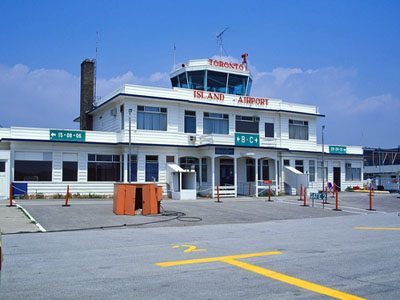Toronto Island Airport Terminal Building National Historic Site of Canada
Toronto, Ontario

General view
© Parks Canada Agency / Agence Parcs Canada.
Address :
Toronto, Ontario
Recognition Statute:
Historic Sites and Monuments Act (R.S.C., 1985, c. H-4)
Designation Date:
1989-06-22
Dates:
-
1938 to 1939
(Construction)
Event, Person, Organization:
-
E.L. Cousins, Toronto Harbour Commission
(Architect)
-
J. Gladwin Hedges, Toronto Harbour Commission
(Architect)
-
Toronto Harbour Commission
(Builder)
Other Name(s):
-
Toronto Island Airport Terminal Building
(Designation Name)
-
Administration Building
(Plaque name)
Research Report Number:
1989-053
Plaque(s)
Existing plaque: Toronto, Ontario
This building is one of the few surviving air terminal buildings dating from the formative years of scheduled air passenger travel. It was constructed in 1938-1939 by the Toronto Harbour Commissioners to service the new Port George VI Airport, now known as the Toronto Island Airport. Geared to efficiency, it centralized passenger, baggage, and air traffic control services in a structure which was placed close to and in full view of the runway. Its horizontal massing, central projecting control tower and attractively landscaped setting were typical of air terminal buildings before the advent of jet aircraft.
Description of Historic Place
The Toronto Island Airport Terminal Building National Historic Site of Canada, built in 1938-9, is a two-storey, wooden aviation terminal with a central control tower. It is located at the western end of the Toronto Islands, across a narrow channel of water from downtown Toronto. The building is part of an operating airport and is surrounded by runways, hangars and other support buildings. The formal recognition consists of the building on its footprint.
Heritage Value
Toronto Island Airport Terminal Building was designated a national historic site of Canada in 1989 because: it is a rare surviving example of air terminal construction dating from the formative years of air passenger travel; and geared to efficiency, it centralized passenger, baggage, and air traffic control services in a structure which was placed close to and in full view of the runway.
Designed and built by the Toronto Harbour Commission in 1938-9, the Toronto Island Airport Terminal Building was part of the first group of aviation terminals to be funded and approved by the newly formed Department of Transport as part of the development of the federally funded Trans-Canada Airway. It is one of very few early terminal buildings to have survived and is likely the oldest, extant, operating terminal of its kind in Canada.
The Toronto Island Airport Terminal Building is typical of early airport facilities in its linear design, massing, orientation and the combination of multiple functions within one structure. Its low, rectangular massing, its fenestration and its minimal detailing reveal the influence of the Modern movement. The Terminal Building provided facilities for passenger and baggage handling (including airmail service and customs and immigration processing), as well as for air traffic control and airport administration. Its design and orientation provide unimpeded views of the landing field for both passengers and airport control staff. Its axial plan facilitates the movement of passengers and baggage through the terminal and between air transportation and the ferry slip.
Source: Historic Sites and Monuments Board of Canada, Minutes, November 1989.
Character-Defining Elements
Key elements contributing to the heritage value of the Toronto Island Airport Terminal Building include: its two-storey, rectangular massing, typical of 1930s terminal buildings with a symmetrical composition, including the central, two-storey section topped by a central, projecting control tower, and flanked by two single-storey lateral wings; features characteristic of 1930s public structures, including its flat roof, projecting cornice, and columned entry porches; features which reveal the influence of the modern movement, including its horizontal massing, large plate glass windows and minimal detailing; its central projecting control tower, including its placement and massing; its clapboard cladding; surviving original interior finishes and evidence of its incorporation of physical facilities for passenger, baggage and air traffic control in a single structure; surviving evidence of its linear approach to the arrangement of space, including the placement of the long side of the building adjacent to the landing field, with passenger and baggage handling functions on the ground floor, and administrative and control functions on the second floor; surviving remnants of the original axial layout of the ground floor space, including a central reception hall housing ticket counters, and side wings accommodating washrooms, mailroom, customs area and offices; surviving remnants of its original circulation pattern, allowing direct passage of passengers from airside to landside through a central lobby; unimpeded views from the ground floor, second floor and control tower to the landing field; its proximity and linear relationship to the runways and other early buildings at the airport; its close relationship to the ferry slip connecting the airport to downtown Toronto.